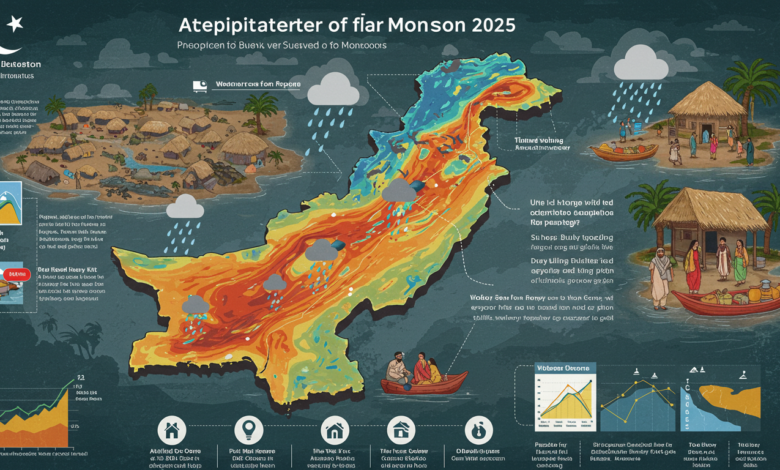🌧️ Monsoon 2025 in Pakistan: What to Expect and How to Prepare

-
Introduction – the significance of Monsoon 2025 You know about theglobespot, andaazdaily, openrendz and monsoon 2025 Pakistan also Buzzfeed.
-
Understanding Monsoon Mechanics in Pakistan
-
Climatological Outlook: June–September 2025
-
Recent Pre-Monsoon Activity
-
Regional Rainfall Forecasts & Anomalies
-
Temperature Trends and Snowmelt Concerns
-
Flood Risk & Preparedness
-
Impact on Agriculture and Water Security
-
Health Impacts & Public Safety
-
Infrastructure & Urban Resilience
-
Disaster Preparedness by Authorities
-
Climate Change & Long-Term Resilience
-
How Individuals Can Prepare
-
Case Studies: Lessons from 2016 & 2022
-
Looking Ahead: Monitoring & Early Warnings
-
Conclusion
1. Introduction: Why Monsoon 2025 Matters
Monsoon season in Pakistan affects millions. It fills reservoirs. It sustains agriculture. However, it also triggers devastating floods, landslides, and urban inundation. With climate shifts intensifying patterns, 2025 promises both opportunity and risk. This article breaks down what’s expected—weather-wise and socially—and how you can prepare.
2. Understanding Monsoon Mechanics in Pakistan
The South Asian summer monsoon, driven by moisture-laden winds from the Bay of Bengal and Arabian Sea, arrives late June and peaks in July–August propakistani.pk+9rnd.pmd.gov.pk+9thefridaytimes.com+9dawn.com+5tribune.com.pk+5arabnews.com+5en.wikipedia.orgeconomictimes.indiatimes.com. It synchronizes with western disturbances, a key driver in spring pre-monsoon weather . Together, they influence rainfall onset, intensity, and distribution.
3. Climatological Outlook: June–September 2025
According to PMD’s seasonal forecast:
-
Overall rainfall: near-normal to slightly above normal (13% above the 30-year average) en.wikipedia.org+8rnd.pmd.gov.pk+8intpolicydigest.org+8.
-
Region-specific outlook:
-
Northern Punjab, AJK, Northeast: +16% to +18% rainfall
-
Sindh & Balochistan: +18% to +19%
-
GB and Northern KP: near-normal
-
-
Temperature forecast: uniformly above normal, especially in mountainous north (+0.5–1.4 °C anomaly) arxiv.org+13rnd.pmd.gov.pk+13facebook.com+13.
4. Recent Pre-Monsoon Activity
PMD reports widespread pre-monsoon rains (June 20–23), bringing relief from intense heat and triggers for dust storms, thunderstorms, hail, and gusty winds across Punjab, KP, Sindh, GB, and AJK thefridaytimes.com+4tribune.com.pk+4dawn.com+4.
Additionally, PMD forecasts full monsoon onset by June 25, 2025 propakistani.pk+1arxiv.org+1.
5. Regional Rainfall Forecasts & Anomalies
Northern Areas
-
GB & Northern KP: normal to slightly below-normal rainfall ptv.com.pk+3rnd.pmd.gov.pk+3thefridaytimes.com+3.
-
Increased risk of Glacial Lake Outburst Floods (GLOFs) from rapid snowmelt rnd.pmd.gov.pk+1thefridaytimes.com+1.
Punjab & AJK
-
Above-normal rainfall (+8% to +16%) .
-
Flood risks in hill torrents and urban zones.
Sindh & Balochistan
-
+18% to +19%; higher heatwave risk thefridaytimes.comarxiv.org+2rnd.pmd.gov.pk+2en.wikipedia.org+2.
-
Heavy events possible leading to flash flooding.
6. Temperature Trends & Snowmelt
Warmer-than-usual conditions will prevail nationwide and especially in the north. Elevated temperatures can accelerate snow- and glacier-melt, adding to river flows and flood risks in KP and GB .
7. Flood Risk & Preparedness
Flash, Urban & Riverine Flooding
-
Flash floods: common in hill torrents of Balochistan, KP, and AJK.
-
Urban flooding: likely in low-lying zones of Lahore, Rawalpindi, Gujranwala, Islamabad, and Karachi arabnews.com+7tribune.com.pk+7rnd.pmd.gov.pk+7.
-
Riverine flooding: expected in Punjab.
Infrastructure Threats
Pre-monsoon events already damaged poles, solar panels, billboards, and vehicles rnd.pmd.gov.pk+14tribune.com.pk+14arabnews.com+14. Continued vigilance is vital.
8. Impact on Agriculture & Water Security
Rainfall bodes well for Kharif crops—rice, cotton, sugarcane, maize gcisc.org.pk+2thewaterchannel.tv+2thefridaytimes.com+2rnd.pmd.gov.pk.
Reservoirs and groundwater will be replenished .
However, low flows in western rivers (Indus, Chenab) due to upstream control pose threats to irrigation economictimes.indiatimes.com+1timesofindia.indiatimes.com+1.
9. Health Impacts & Public Safety
Stagnant water will raise risk of waterborne diseases like cholera, dengue, malaria intpolicydigest.org.
Heat waves might extend in non-monsoon pockets, stressing vulnerable groups.
10. Infrastructure & Urban Resilience
Weak urban drainage will worsen flooding. Cities must:
-
Repair drains
-
Retrofit bridges
-
Secure loose structures
-
Learn from previous floods arabnews.com+3thewaterchannel.tv+3intpolicydigest.org+3arabnews.com+2dawn.com+2arabnews.com+2.
Dengue control, sanitation, and clean water systems must be prepped.
11. Disaster Preparedness by Authorities
PMD and PDMA are advising:
-
Early warning systems
-
Structural inspections
-
Public advisories on travel & crops
-
Flood rescue planning dawn.com+5arabnews.com+5arabnews.com+5.
A Climate Application Forum in May coordinated scientific planning among agencies thefridaytimes.com+1youtube.com+1.
12. Climate Change & Long‑Term Resilience
Climate change is increasing monsoon intensity. Pakistan is ranked among the top five most vulnerable arabnews.com.
Floods of 2016 and 2022 illustrate the magnitude of risks when resilience systems fail.
13. How Individuals Can Prepare
Before the Monsoon
-
Clear drains
-
Reinforce rooftops & panels
-
Stock essentials—water, medicines
-
Make evacuation plans
During the Monsoon
-
Monitor PMD alerts
-
Avoid risky areas
-
Store safe drinking water
-
Stay alert for disease outbreaks
After the Monsoon
-
Inspect home damage
-
Prevent water contamination
-
Replant crops if needed
-
Report debris and obstructions
14. Case Studies: Lessons from 2016 & 2022
2016 Pre-Monsoon Floods
Over 400 deaths in KP. Buildings collapsed, vehicles swept away arabnews.com+3thefridaytimes.com+3dawn.com+3.
2022 Devastating Floods
Affected 33 million, over 1,700 deaths, infrastructure losses exceeded $35 billion arabnews.com+1arabnews.com+1.
Both events highlight climate-driven vulnerabilities.
15. Looking Ahead: Monitoring & Early Warnings
-
Utilize PMD forecasts and apps
-
Leverage satellite & radar data
-
Coordinate community-level early warnings
-
Strengthen integration between agencies
Climate adaptation, resilient infrastructure, and community awareness are key to reducing disaster impacts.
16. Conclusion
Monsoon 2025 in Pakistan holds promise and peril. Overall rainfall may be slightly above normal, benefiting crops and water stores. But temperature rise, flash floods, urban inundation, and health risks pose threats. Persistent challenges—from urban resilience to cross-border river flows—must be addressed through planning, infrastructure, and individual awareness.
The coming months will test systems already stretched by past events and climate change. Preparation, not panic, is our best ally. Stay informed. Stay ready. Be safe.



